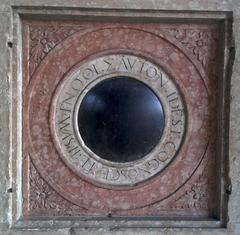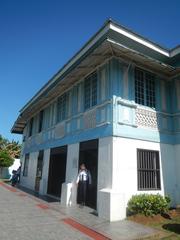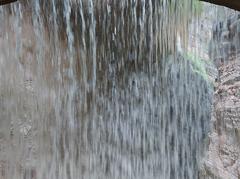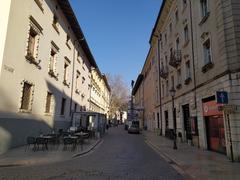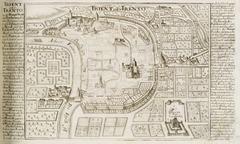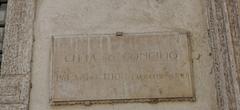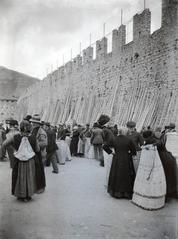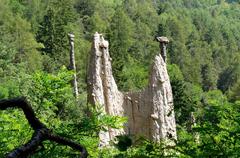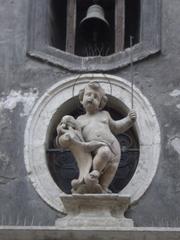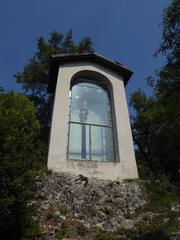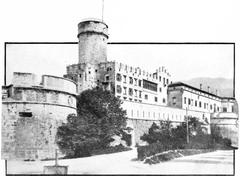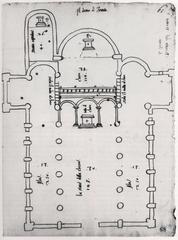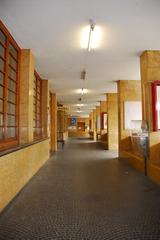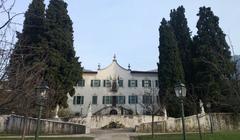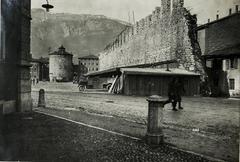Comprehensive Guide to Visiting Museo Nazionale Storico degli Alpini, Trento, Italy
Date: 31/07/2024
Introduction
Nestled in the heart of Trento, Italy, the Museo nazionale storico degli Alpini offers a profound journey through the storied past of the Corpo degli Alpini, an elite mountain warfare corps of the Italian Army. Established to preserve the legacy and valor of the Alpini, the museum is strategically located on the historically significant Doss Trento hill. This site not only offers breathtaking views of the Adige Valley but also holds historical significance dating back to prehistoric and Roman times. The museum was officially inaugurated in 1958 and has since become a beacon of military history (cultura.trentino.it).
Visitors can explore a rich collection of artifacts, from uniforms and weapons to personal items and memorabilia, that chronicle the history of the Alpini from their inception to the present day. The museum also features modern multimedia installations, interactive displays, and film projections that provide an engaging and educational experience for all ages. Recent renovations have further enhanced the visitor experience, making the museum more accessible and interactive (comune.trento.it). Whether you are a history enthusiast or a casual visitor, the Museo nazionale storico degli Alpini offers a unique opportunity to delve into the bravery and resilience of one of Italy’s most storied military units.
Table of Contents
- [Introduction](#introductionintroduction)
- [Historical Background of Museo nazionale storico degli Alpini](#historical-background-of-museo-nazionale-storico-degli-alpinihistorical-background-of-museo-nazionale-storico-degli-alpini)
- [Origins and Foundation](#origins-and-foundationorigins-and-foundation)
- [Construction and Inauguration](#construction-and-inaugurationconstruction-and-inauguration)
- [Architectural and Historical Significance](#architectural-and-historical-significancearchitectural-and-historical-significance)
- [Exhibits and Collections](#exhibits-and-collectionsexhibits-and-collections)
- [The Sala delle Medaglie d’Oro](#the-sala-delle-medaglie-dorothe-sala-delle-medaglie-doro)
- [The Museo del Mulo](#the-museo-del-mulothe-museo-del-mulo)
- [Recent Developments](#recent-developmentsrecent-developments)
- [Visitor Information and Tips](#visitor-information-and-tipsvisitor-information-and-tips)
- [Visiting Hours and Ticket Information](#visiting-hours-and-ticket-informationvisiting-hours-and-ticket-information)
- [Accessibility and Facilities](#accessibility-and-facilitiesaccessibility-and-facilities)
- [Guided Tours and Special Events](#guided-tours-and-special-eventsguided-tours-and-special-events)
- [Nearby Attractions](#nearby-attractionsnearby-attractions)
- [Conclusion](#conclusionconclusion)
- [FAQ](#faqfaq)
- [What are the visiting hours for Museo nazionale storico degli Alpini?](#what-are-the-visiting-hours-for-museo-nazionale-storico-degli-alpiniwhat-are-the-visiting-hours-for-museo-nazionale-storico-degli-alpini)
- [How much are the tickets for the museum?](#how-much-are-the-tickets-for-the-museumhow-much-are-the-tickets-for-the-museum)
- [Are guided tours available?](#are-guided-tours-availableare-guided-tours-available)
- [Is the museum accessible to visitors with disabilities?](#is-the-museum-accessible-to-visitors-with-disabilitiesis-the-museum-accessible-to-visitors-with-disabilities)
- [What other attractions are nearby?](#what-other-attractions-are-nearbywhat-other-attractions-are-nearby)
Historical Background of Museo nazionale storico degli Alpini
Origins and Foundation
The Museo nazionale storico degli Alpini, located in Trento, Italy, is dedicated to the history and legacy of the Corpo degli Alpini, an elite mountain warfare military corps of the Italian Army. The idea to establish a museum in honor of the Alpini was conceived by the Legione Trentina, with support from the Comando Superiore delle Truppe Alpine and the Associazione Nazionale Alpini. The proposal was officially accepted by the Italian government in 1938, and the chosen site was the Doss Trento, also known as Verruca, a natural park with historical significance dating back to prehistoric and Roman times (cultura.trentino.it).
Construction and Inauguration
The construction of the museum complex began with the inauguration of an access road by General C.A. Gabriele Nasci in June 1942. The road and a piazzale were intended to complete the monument dedicated to the Alpini. In 1953, the Comune di Trento donated an ex-Austrian powder magazine, and on May 24, 1956, the first stone of the museum was laid. The official inauguration of the Museo-Sacrario took place on March 15, 1958, during the 31st national gathering of the Alpini in Trento (cultura.trentino.it).
Architectural and Historical Significance
The museum is strategically located on the Doss Trento, a site that has served various historical purposes over the centuries. From prehistoric settlements to Roman fortifications, the area has been a significant vantage point overlooking the Adige Valley. The museum itself has undergone recent renovations, presenting a modern facade while preserving its historical essence. A notable feature is the short staircase leading to the entrance, flanked by two anti-tank cannons (47/32) and a 100/17 artillery piece (trentino.com).
Exhibits and Collections
Inside the museum, visitors can explore a comprehensive collection that chronicles the history of the Alpini from their inception to the present day. The exhibits include trophies, weapons, and memorabilia displayed in individual niches and showcases. One of the highlights is a precious triptych by Mario Urbani titled “Falchi e prede,” painted in the trenches during World War I. The museum also features two mountain artillery pieces: the 65/17 and the Skoda 75/13 (cultura.trentino.it).
The Sala delle Medaglie d’Oro
A significant part of the museum is the Sala delle Medaglie d’Oro, dedicated to the Alpini who have been awarded the Gold Medal for Military Valor. The room features a prominent panel depicting “La morte del Capitano” by Col. Paolo Caccia Dominioni, in memory of Captain Giuseppe Grandi of the Alpini Battalion “Tirano.” The walls are adorned with the names of decorated soldiers from the wars between 1896 and 1945, engraved on large white marble slabs. At the center of the room is a boulder from Monte Grappa, surrounded by a poignant representation of the battlefields where the Alpini fought (cultura.trentino.it).
The Museo del Mulo
Another unique aspect of the museum is the Museo del Mulo, which showcases materials related to the care and equipment of mules, essential companions of the Alpini in mountainous terrains. Although the museum is a single small room visible only through external windows, it provides an intriguing glimpse into the logistical challenges faced by the Alpini (cultura.trentino.it).
Recent Developments
In 2019, the museum underwent significant renovations to modernize its facilities and enhance the visitor experience. The updated museum now includes multimedia installations, touchscreen displays, and film projections that narrate the evolution of the Alpini Corps. The renovation also uncovered archaeological artifacts from the Longobard era, adding another layer of historical depth to the museum’s offerings (comune.trento.it).
Visitor Information and Tips
Visiting Hours and Ticket Information
The museum is open from Tuesday to Thursday (08:15 - 12:00 and 13:15 - 16:15), Friday (08:15 - 12:00), and on weekends (09:00 - 12:00 and 13:30 - 17:00). It is closed on Mondays. For the latest opening hours and additional information, visitors are advised to check the museum’s official website (museonazionalealpini.it). Ticket prices vary, with special rates for groups, seniors, and children.
Accessibility and Facilities
The museum is accessible to visitors with disabilities, with provisions such as ramps and designated parking spaces. However, the path leading to the museum has slopes ranging from 7% to 10%, and the surrounding area is paved with slightly irregular porphyry slabs.
Guided Tours and Special Events
Guided tours are available upon request and can provide a more in-depth understanding of the museum’s exhibits. The museum also hosts special events and temporary exhibitions throughout the year, so be sure to check the website for the latest updates.
Nearby Attractions
While in Trento, consider visiting other notable historical sites such as the Buonconsiglio Castle, the Trento Cathedral, and the MUSE - Museo delle Scienze. These attractions, along with the Museo nazionale storico degli Alpini, offer a rich cultural experience in this beautiful region of Italy.
Conclusion
The Museo nazionale storico degli Alpini stands as a testament to the bravery and resilience of the Alpini Corps. Through its extensive collections, historical artifacts, and modern exhibits, the museum offers a profound insight into the storied past of these elite mountain troops. Whether you are a history enthusiast or a casual visitor, the museum provides a rich and engaging experience that honors the legacy of the Alpini. Be sure to check the visiting hours, ticket information, and plan your trip to include nearby attractions for a full experience of Trento’s historical sites.
FAQ
What are the visiting hours for Museo nazionale storico degli Alpini?
The museum is open from Tuesday to Thursday (08:15 - 12:00 and 13:15 - 16:15), Friday (08:15 - 12:00), and on weekends (09:00 - 12:00 and 13:30 - 17:00). It is closed on Mondays. For the latest opening hours, visit the museum’s official website.
How much are the tickets for the museum?
Ticket prices vary and may include discounts for groups, seniors, and children. Check the museum’s official website for the most current pricing information.
Are guided tours available?
Yes, guided tours are available upon request and can provide a more comprehensive understanding of the museum’s exhibits. Contact the museum in advance to arrange a tour.
Is the museum accessible to visitors with disabilities?
The museum is accessible, offering ramps and designated parking spaces. However, the path leading to the museum has slopes ranging from 7% to 10%, and the surrounding area is paved with slightly irregular porphyry slabs.
What other attractions are nearby?
Nearby attractions include the Buonconsiglio Castle, the Trento Cathedral, and the MUSE - Museo delle Scienze. These sites, along with the Museo nazionale storico degli Alpini, provide a rich cultural experience in Trento.
References
- cultura.trentino.it, Museo nazionale storico degli Alpini. Retrieved from cultura.trentino.it.
- comune.trento.it, Museo nazionale storico degli Alpini. Retrieved from comune.trento.it.
- trentino.com, Museo nazionale storico degli Alpini. Retrieved from trentino.com.
